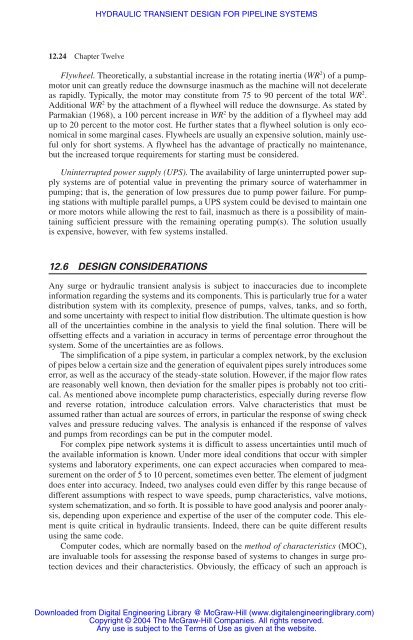chapter 12 hydraulic transient design for pipeline systems
chapter 12 hydraulic transient design for pipeline systems
chapter 12 hydraulic transient design for pipeline systems
You also want an ePaper? Increase the reach of your titles
YUMPU automatically turns print PDFs into web optimized ePapers that Google loves.
<strong>12</strong>.24 Chapter Twelve<br />
HYDRAULIC TRANSIENT DESIGN FOR PIPELINE SYSTEMS<br />
Flywheel. Theoretically, a substantial increase in the rotating inertia (WR 2 ) of a pumpmotor<br />
unit can greatly reduce the downsurge inasmuch as the machine will not decelerate<br />
as rapidly. Typically, the motor may constitute from 75 to 90 percent of the total WR 2 .<br />
Additional WR 2 by the attachment of a flywheel will reduce the downsurge. As stated by<br />
Parmakian (1968), a 100 percent increase in WR 2 by the addition of a flywheel may add<br />
up to 20 percent to the motor cost. He further states that a flywheel solution is only economical<br />
in some marginal cases. Flywheels are usually an expensive solution, mainly useful<br />
only <strong>for</strong> short <strong>systems</strong>. A flywheel has the advantage of practically no maintenance,<br />
but the increased torque requirements <strong>for</strong> starting must be considered.<br />
Uninterrupted power supply (UPS). The availability of large uninterrupted power supply<br />
<strong>systems</strong> are of potential value in preventing the primary source of waterhammer in<br />
pumping; that is, the generation of low pressures due to pump power failure. For pumping<br />
stations with multiple parallel pumps, a UPS system could be devised to maintain one<br />
or more motors while allowing the rest to fail, inasmuch as there is a possibility of maintaining<br />
sufficient pressure with the remaining operating pump(s). The solution usually<br />
is expensive, however, with few <strong>systems</strong> installed.<br />
<strong>12</strong>.6 DESIGN CONSIDERATIONS<br />
Any surge or <strong>hydraulic</strong> <strong>transient</strong> analysis is subject to inaccuracies due to incomplete<br />
in<strong>for</strong>mation regarding the <strong>systems</strong> and its components. This is particularly true <strong>for</strong> a water<br />
distribution system with its complexity, presence of pumps, valves, tanks, and so <strong>for</strong>th,<br />
and some uncertainty with respect to initial flow distribution. The ultimate question is how<br />
all of the uncertainties combine in the analysis to yield the final solution. There will be<br />
offsetting effects and a variation in accuracy in terms of percentage error throughout the<br />
system. Some of the uncertainties are as follows.<br />
The simplification of a pipe system, in particular a complex network, by the exclusion<br />
of pipes below a certain size and the generation of equivalent pipes surely introduces some<br />
error, as well as the accuracy of the steady-state solution. However, if the major flow rates<br />
are reasonably well known, then deviation <strong>for</strong> the smaller pipes is probably not too critical.<br />
As mentioned above incomplete pump characteristics, especially during reverse flow<br />
and reverse rotation, introduce calculation errors. Valve characteristics that must be<br />
assumed rather than actual are sources of errors, in particular the response of swing check<br />
valves and pressure reducing valves. The analysis is enhanced if the response of valves<br />
and pumps from recordings can be put in the computer model.<br />
For complex pipe network <strong>systems</strong> it is difficult to assess uncertainties until much of<br />
the available in<strong>for</strong>mation is known. Under more ideal conditions that occur with simpler<br />
<strong>systems</strong> and laboratory experiments, one can expect accuracies when compared to measurement<br />
on the order of 5 to 10 percent, sometimes even better. The element of judgment<br />
does enter into accuracy. Indeed, two analyses could even differ by this range because of<br />
different assumptions with respect to wave speeds, pump characteristics, valve motions,<br />
system schematization, and so <strong>for</strong>th. It is possible to have good analysis and poorer analysis,<br />
depending upon experience and expertise of the user of the computer code. This element<br />
is quite critical in <strong>hydraulic</strong> <strong>transient</strong>s. Indeed, there can be quite different results<br />
using the same code.<br />
Computer codes, which are normally based on the method of characteristics (MOC),<br />
are invaluable tools <strong>for</strong> assessing the response based of <strong>systems</strong> to changes in surge protection<br />
devices and their characteristics. Obviously, the efficacy of such an approach is<br />
Downloaded from Digital Engineering Library @ McGraw-Hill (www.digitalengineeringlibrary.com)<br />
Copyright © 2004 The McGraw-Hill Companies. All rights reserved.<br />
Any use is subject to the Terms of Use as given at the website.
















